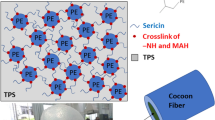Abstract
Octenyl succinate hydroxypropyl acidolysis tamarind gum (OSA-HATG) with a high substitution degree of ester groups was first synthesized using hydroxypropyl acidolysis tamarind gum (HATG) as a raw material, 1-butyl-3-methylimidazolium chloride (ionic liquid) as a solvent, octenyl succinic anhydride (OSA) as an acylating agent, and 4-dimethylamino pyridine (DMAP) as a catalyst. The results showed that OSA-HATG, as a new emulsifier, has good emulsification capacity and stability. The emulsifying capacity of OSA-HATG increased with increasing substitution degree. Acidolysis (acid hydrolysis) and hydroxypropylation were mainly conducted on the large particles of TG. The stretching vibration peaks of the C=O bonds at 1735 cm−1 and C=C bonds at 1654 cm−1 indicated that the acylation of HATG by OSA was successfully accomplished. TG was almost amorphous. The acylation resulted in a reduction in the thermal stability of OSA-HATG but obviously increased the contact angle of OSA-HATG (102.7°). The addition of TG and its derivatives did not improve the setback of potato starch. The acidolysis and hydroxypropylation could swell the TG particles.
This is a preview of subscription content, access via your institution
Access options
Subscribe to this journal
Receive 12 print issues and online access
$259.00 per year
only $21.58 per issue
Buy this article
- Purchase on Springer Link
- Instant access to full article PDF
Prices may be subject to local taxes which are calculated during checkout





Similar content being viewed by others
References
Poommarinvarakul S, Tattiyakul J, Muangnapoh C. Isolation and rheological properties of tamarind seed polysaccharide from tamarind kernel powder using protease enzyme and high-intensity ultrasound. J Food Sci. 2010;75:E253–60. https://doi.org/10.1111/j.1750-3841.2010.01613.x.
Ponnikornkit B, Ngamsalak C, Huanbutta K, Sittikijyothin W. Swelling behaviour of carboxymethylated tamarind gum. Advanced Materials Research. 2014;1060:137–40. https://doi.org/10.4028/www.scientific.net/AMR.1060.137.
Goyal P, Kumar V, Sharma P. Carboxymethylation of tamarind kernel powder. Carbohydr Polym. 2007;69:251–5. https://doi.org/10.1016/j.carbpol.2006.10.001.
Khounvilay K, Sittikijyothin W. Rheological behaviour of tamarind seed gum in aqueous solutions. Food Hydrocoll. 2012;26:334–8. https://doi.org/10.1016/j.foodhyd.2011.03.019.
Alpizar-Reyes E, Carrillo-Navas H, Romero-Romero R, Varela-Guerrero V, Alvarez-Ramírez J, Pérez-Alonso C. Thermodynamic sorption properties and glass transition temperature of tamarind seed mucilage (Tamarindus indica L.). Food Bioprod Process. 2017;101:166–76. https://doi.org/10.1016/j.fbp.2016.11.006.
Shao H, Zhang H, Tian Y, Song Z, Lai P, Ai L. Composition and rheological properties of polysaccharide extracted from tamarind (Tamarindus indica L.) seed. Molecules. 2019;24:1–13. https://doi.org/10.3390/molecules24071218.
Jang KJ, Hong YE, Moon Y, Jeon S, Angalet S, Kweon M. Exploring the applicability of tamarind gum for making gluten-free rice bread. Food Sci Biotechnol. 2018;27:1639–48. https://doi.org/10.1007/s10068-018-0416-z.
Nayak AK, Pal D. Tamarind seed polysaccharide: an emerging excipient for pharmaceutical use. Indian J Pharm Educ Res. 2017;51:s136–46. https://doi.org/10.5530/ijper.51.2s.60.
Sharma V, Patnaik P, Senthilguru K, Nayak SK, Syed I, Singh VK, et al. Preparation and characterization of novel tamarind gum-based hydrogels for antimicrobial drug delivery applications. Chem Pap. 2018;72:2101–13. https://doi.org/10.1007/s11696-018-0414-x.
Singh V, Ali SZ. Properties of starches modified by different acids. Int J Food Prop. 2008;11:495–507. https://doi.org/10.1080/10942910802083774.
Tang HB, Liu YH, Li YP, Li Q, Liu XJ. Hydroxypropylation of cross-linked sesbania gum, characterization and properties. Int J Biol Macromol. 2020;152:1010–9. https://doi.org/10.1016/j.ijbiomac.2019.10.188.
Zhu JJ, Guo PP, Chen DH, Xu K, Wang PX, Guan S. Fast and excellent healing of hydroxypropyl guar gum/poly(N,N-dimethyl acrylamide) hydrogels. J Polym Sci Part B Polym Phys. 2018;56:239–47. https://doi.org/10.1002/polb.24514.
Wang C, He XW, Huang Q, Luo FX, Fu X. The mechanism of starch granule reacted with OSA by phase transition catalyst in aqueous medium. Food Chem. 2013;141:3381–5. https://doi.org/10.1016/j.foodchem.2013.06.029.
Hong Y, Li ZS, Gu ZB, Wang Y, Pang YS. Structure and emulsification properties of octenyl succinic anhydride starch using acid-hydrolyzed method. Starch/Stärke. 2017;68:1–9. https://doi.org/10.1002/star.201600039.
Tesch S, Gerhards CH, Schubert H. Stabilization of emulsions by OSA starches. J Food Eng. 2002;54:167–74. https://doi.org/10.1016/S0260-8774(01)00206-0.
Lin QQ, Liang R, Zhong F, Ye A, Singh H. Effect of degree of octenyl succinic anhydride (OSA) substitution on the digestion of emulsions and the bioaccessibility of β-carotene in OSA-modified-starch-stabilized-emulsions. Food Hydrocoll. 2018;84:303–12. https://doi.org/10.1016/j.foodhyd.2018.05.056.
Sweedman MC, Tizzotti MJ, Schafer C, Gilbert RG. Structure and physicochemical properties of octenyl succinic anhydride modified starches: a review. Carbohydr Polym. 2013;92:905–20. https://doi.org/10.1016/j.carbpol.2012.09.040.
Holbrey JD, Seddon KR. The phase behaviour of 1-alkyl-3-methylimidazolium tetrafluoroborates; ionic liquids and ionic liquid crystals. J Chem Soc Dalton Trans. 1999;13:2133–9. https://doi.org/10.1039/a902818h.
Ibrahim F, Moniruzzaman M, Yusup S, Uemura Y. Dissolution of cellulose with ionic liquid in pressurized cell. J Mol Liq. 2015;211:370–2. https://doi.org/10.1016/j.molliq.2015.07.041.
Tang HB, Sun M, Li YP, Dong SQ. Preparation and properties of partially hydrolyzed cross-linked guar gum. Polym Bull. 2013;70:3331–46. https://doi.org/10.1007/s00289-013-1025-x.
Tang HB, Tang HB, Li YP. Synthesis, optimization, characterization and property of oxidized hydroxypropyl mung bean starch. J Food Process Preserv. 2017;41:e12763. https://doi.org/10.1111/jfpp.12763.
Chen LS, Fu FW, Wei VKW. On the constructions and nonlinearity of binary vector-output correlation-immune functions. J Complex. 2004;20:266–83. https://doi.org/10.1016/j.jco.2003.08.015.
Sun M, Tang HB, Dong SQ, Li YP. Preparation, properties of partially hydrolized guar gum. Adv Mat Res. 2013;781–784: 1901–6. https://doi.org/10.4028/www.scientific.net/AMR.781-784.1901.
Maulani RR, Fardiaz D, Kusnandar F, Sunarti TC. Characterization of chemical and physical properties of hydroxypropylated and cross-linked arrowroot (Marantha arundinacea) starch. J Eng Technol Sci. 2013;45:207–21. https://doi.org/10.5614/j.eng.technol.sci.2013.45.3.1.
Tang HB, Sun PX, Li YP, Dong SQ. Esterification of sesbania gum hydrolysate in ionic liquid, optimization and characterization of its derivatives. Arab J Sci Eng. 2019;44:6381–92. https://doi.org/10.1007/s13369-019-03844-4.
Zou Y, Guo J, Yin SW, Wang JM, Yang XQ. Pickering emulsion gels prepared by hydrogen-bonded zein/tannic acid complex colloidal particles. J Agric Food Chem. 2015;63:7405–14. https://doi.org/10.1021/acs.jafc.5b03113.
Oliveira NM, Dourado FQ, Peres AM, Silva MV, Maia JM, Teixeira JA. Effect of guar gum on the physicochemical, thermal, rheological and textural properties of green edam cheese. Food Bioprocess Technol. 2010;4:1414–21. https://doi.org/10.1007/s11947-010-0324-6.
Tang HB, Qu YF, Li YP, Dong SQ. Surface modification mechanism of cross-linking and acetylation, and their influence on characteristics of high amylose corn starch. J Food Sci. 2018;83:1533–41. https://doi.org/10.1111/1750-3841.14161.
Kim HY, Jane JL, Lamsal B. Hydroxypropylation improves film properties of high amylose corn starch. Ind Crops Products. 2017;95:175–83. https://doi.org/10.1016/j.indcrop.2016.10.025.
Yang LP, Zhou YB, Wu YM, Meng X, Jiang YM, Zhang HW, et al. Preparation and physicochemical properties of three types of modified glutinous rice starches. Carbohydr Polym. 2016;137:305–13. https://doi.org/10.1016/j.carbpol.2015.10.065.
Dai Z. Starch granule size distribution in grains at different positions on the spike of wheat (Triticum aestivum L.). Starch/Stärke. 2009;61:582–9. https://doi.org/10.1002/star.200800112.
Ma YS, Pan Y, Xie QT, Li XM, Zhang B, Chen HQ. Evaluation studies on effects of pectin with different concentrations on the pasting, rheological and digestibility properties of corn starch. Food Chem. 2019;274:319–23. https://doi.org/10.1016/j.foodchem.2018.09.005.
No J, Shin M. Preparation and characteristics of octenyl succinic anhydride-modified partial waxy rice starches and encapsulated paprika pigment powder. Food Chem. 2019;295:466–74. https://doi.org/10.1016/j.foodchem.2019.05.064.
Li WY, Jin AX, Liu CF, Sun RC, Zhang AP, Kennedy JF. Homogeneous modification of cellulose with succinic anhydride in ionic liquid using 4-dimethylaminopyridine as a catalyst. Carbohydr Polym. 2009;78:389–95. https://doi.org/10.1016/j.carbpol.2009.04.028.
Liu ZQ, Li Y, Cui FJ, Ping LF, Song JN, Ravee Y, et al. Production of octenyl succinic anhydride-modified waxy corn starch and its characterization. J Agric Food Chem. 2008;56:11499–506. https://doi.org/10.1021/jf802317q.
Minnick DL, Flores RA, DeStefano MR, Scurto AM. Cellulose solubility in ionic liquid mixtures: temperature, cosolvent, and antisolvent effects. J Phys Chem B. 2016;120:7906–19. https://doi.org/10.1021/acs.jpcb.6b04309.
Luan YH, Zhang JM, Zhan MS, Wu J, Zhang J, He JS. Highly efficient propionylation and butyralation of cellulose in an ionic liquid catalyzed by 4-dimethylminopyridine. Carbohydr Polym. 2013;92:307–11. https://doi.org/10.1016/j.carbpol.2012.08.111.
Wang H, Williams PA, Senan C. Synthesis, characterization and emulsification properties of dodecenyl succinic anhydride derivatives of gum arabic. Food Hydrocoll. 2014;37:143–8. https://doi.org/10.1016/j.foodhyd.2013.10.033.
Xu J, Zhou CW, Wang RZ, Yang L, Du SS, Wang FP, et al. Lipase-coupling esterification of starch with octenyl succinic anhydride. Carbohydr Polym. 2012;87:2137–44. https://doi.org/10.1016/j.carbpol.2011.10.035.
Cizova A, Srokova I, Sasinkova V, Malovikova A, Ebringerova A. Carboxymethyl starch octenylsuccinate: microwave- and ultrasound-assisted synthesis and properties. Starch/Stärke. 2008;60:389–97. https://doi.org/10.1002/star.200800221.
Alpizar-Reyes E, Carrillo-Navas H, Gallardo-Rivera R, Varela-Guerrero V, Alvarez-Ramirez J, Pérez-Alonso C. Functional properties and physicochemical characteristics of tamarind (Tamarindus indica L.) seed mucilage powder as a novel hydrocolloid. J Food Eng. 2017;209:68–75. https://doi.org/10.1016/j.jfoodeng.2017.04.021.
Kaur H, Yadav S, Ahuja M, Dilbaghi N. Synthesis, characterization and evaluation of thiolated tamarind seed polysaccharide as a mucoadhesive polymer. Carbohydr Polym. 2012;90:1543–9. https://doi.org/10.1016/j.carbpol.2012.07.028.
Ren L, Dong Z, Jiang M, Tong J, Zhou J. Hydrophobization of starch nanocrystals through esterification in green media. Ind Crops Products. 2014;59:115–8. https://doi.org/10.1016/j.indcrop.2014.05.014.
Acknowledgements
We are grateful to people for our research support.
Author information
Authors and Affiliations
Contributions
The manuscript was written through the contributions of all authors. All authors have given approval to the final version of the manuscript.
Corresponding author
Ethics declarations
Conflict of interest
The authors declare no competing interests.
Additional information
Publisher’s note Springer Nature remains neutral with regard to jurisdictional claims in published maps and institutional affiliations.
Rights and permissions
Springer Nature or its licensor (e.g. a society or other partner) holds exclusive rights to this article under a publishing agreement with the author(s) or other rightsholder(s); author self-archiving of the accepted manuscript version of this article is solely governed by the terms of such publishing agreement and applicable law.
About this article
Cite this article
Hongbo, T., Manxin, W., Yanping, L. et al. Octenyl succinate hydroxypropyl acidolysis tamarind gum: synthesis, optimization, structure and properties. Polym J 55, 13–25 (2023). https://doi.org/10.1038/s41428-022-00702-3
Received:
Revised:
Accepted:
Published:
Issue Date:
DOI: https://doi.org/10.1038/s41428-022-00702-3



